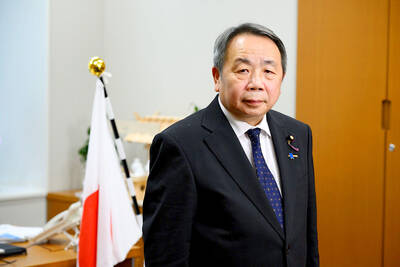President Tsai Ing-wen’s (蔡英文) approval rating has rallied to more than 30 percent following Premier William Lai’s (賴清德) inauguration this month, while 60 percent of voters would not support councilor candidates affiliated with former president Chen Shui-bian (陳水扁) in next year’s election, a poll released yesterday by the Taiwan Brain Trust said.
Tsai’s performance was satisfactory to 34.6 percent of the respondents, while 48.7 percent said they were dissatisfied, the poll showed.
The 34.6 percent satisfaction rate — rising from 28.5 percent in June — was the highest approval rating among the think tank’s surveys since April, while the dissatisfaction rate fell from 56.3 percent in June to 48.7 percent this month.

Photo: CNA
While 61.5 percent of the respondents said they had confidence in Lai’s performance, only 20.8 percent said they did not.
The Cabinet reshuffle launched by Lai on Sept. 8, in which only three minister-level officials were replaced, was satisfactory to 39.7 percent of the respondents, while 31.4 percent were dissatisfied, the survey showed.
Minister of National Defense Feng Shih-kuan (馮世寬), Minister of Justice Chiu Tai-san (邱太三) and Minister of Foreign Affairs David Lee (李大維) were among the most unpopular Cabinet members, with disapproval ratings of 47.6 percent, 45.3 percent and 40.9 percent respectively and approval ratings of 30.3 percent, 28 percent and 31.1 percent.
“There is a large gap between the approval ratings of the premier and his Cabinet because the reshuffle was a minor one. It remains to be seen if the minimally restructured Cabinet can keep up with the highly popular Lai,” Taiwan Brain Trust executive officer Chen Chih-chung (陳致中) said.
A large portion of Tsai’s supporters are people older than 60 and people with only an elementary-school education, whose support for Tsai is mainly based on sentiment, while people with higher education are particularly dissatisfied with Tsai, National Dong Hwa University professor Shih Cheng-feng (施正鋒) said.
In terms of party preference, 33.6 percent of respondents identified with the Democratic Progressive Party (DPP), 23.9 percent with the Chinese Nationalist Party (KMT), 12.3 percent with the New Power Party (NPP) and 4.5 percent with the People First Party (PFP), while 14.4 percent said they are neutral.
The popularity of the DPP has climbed from a low of 26.7 percent in October last year to 33.6 percent this month, nearly as high as its 35.1 percent rating in April last year, one month before Tsai’s administration was sworn in.
The popularity of the KMT has been rising steadily, from a low of 17.2 percent in April last year to 23.9 percent this month, while the NPP’s popularity has fluctuated between 10.5 percent and 15.4 percent in the same period.
The DPP remains the most popular party in the nation, although it is without a strong approval rating.
While 29.4 percent of respondents disapproved of the DPP, more than 40 percent said the performance of other parties was unsatisfying, including the KMT (42.9 percent disapproval), the NPP (44 percent disapproval) and the PFP (48.7 percent disapproval).
While 34.8 percent had a negative impression about the DPP, the KMT was negatively perceived by 45.4 percent of respondents, the NPP by 49.4 percent and the PFP by 52.6 percent.
In next year’s councilor elections, 37 percent of respondents said they would vote for the pan-green camp, including 30.4 percent for the DPP, 4.6 percent for the NPP and 1.3 percent for the Green Party, and 25.8 percent said they would vote for the pan-blue camp, including 23 percent for the KMT and 1.5 percent for the PFP, while 32.9 percent were undecided.
While 21.4 percent of respondents said they would refuse to vote for the KMT, 15.3 percent would spurn the DPP and 11.5 percent would reject the NPP in the councilor elections next year.
While 60.6 percent of respondents indicated they would refuse to vote for councilor candidates endorsed by Chen Shui-bian’s “one country on each side” faction, 22.8 percent might support those candidates, said the think tank, which is affiliated with the former president.
The survey, conducted on Sept. 14 and Sept. 15, collected 1,076 samples with a confidence level of 95 percent and a margin of error of 3 percentage points.

A strong continental cold air mass is to bring pollutants to Taiwan from tomorrow, the Ministry of Environment said today, as it issued an “orange” air quality alert for most of the country. All of Taiwan except for Hualien and Taitung counties is to be under an “orange” air quality alert tomorrow, indicating air quality that is unhealthy for sensitive groups. In China, areas from Shandong to Shanghai have been enveloped in haze since Saturday, the ministry said in a news release. Yesterday, hourly concentrations of PM2.5 in these areas ranged from 65 to 160 micrograms per cubic meter (mg/m³), and pollutants were

Taiwan’s armed forces have established response protocols for a wide range of sudden contingencies, including the “Wan Chun Plan” to protect the head of state, the Ministry of Defense (MND) said today. After US President Donald Trump on Saturday launched a series of airstrikes in Venezuela and kidnapped Venezuelan President Nicolas Maduro, concerns have been raised as to whether China would launch a similar “decapitation strike” on Taiwan. The armed forces regularly coordinate with relevant agencies and practice drills to ensure preparedness for a wide range of scenarios, Vice Minister of National Defense Hsu Szu-chien (徐斯儉) told reporters before a

EVA Airways on Saturday said that it had suspended a pilot and opened an investigation after he allegedly lost his temper and punched the first officer several times as their plane was taxiing before takeoff at Los Angeles International Airport. According to a report published on Thursday by The Reporter, the incident occurred after the flight’s Malaysian first officer tried to warn the Taiwanese pilot, surnamed Wen (文), that he was taxiing faster than the speed limit of 30 knots (55.6kph). After alerting the pilot several times without response, the first officer manually applied the brakes in accordance with standard operating

Japanese Councilor Hei Seki (石平) on Wednesday said that he plans to visit Taiwan, saying that would “prove that Taiwan is an independent country and does not belong to China.” Seki, a member of the Japan Innovation Party, was born in Chengdu in China’s Sichuan Province and became a naturalized Japanese in 2007. He was elected to the House of Concilors last year. His views on the Chinese Communist Party (CCP) — espoused in a series of books on politics and history — prompted Beijing to sanction him, including barring Seki from traveling to China. Seki wrote on X that he intends